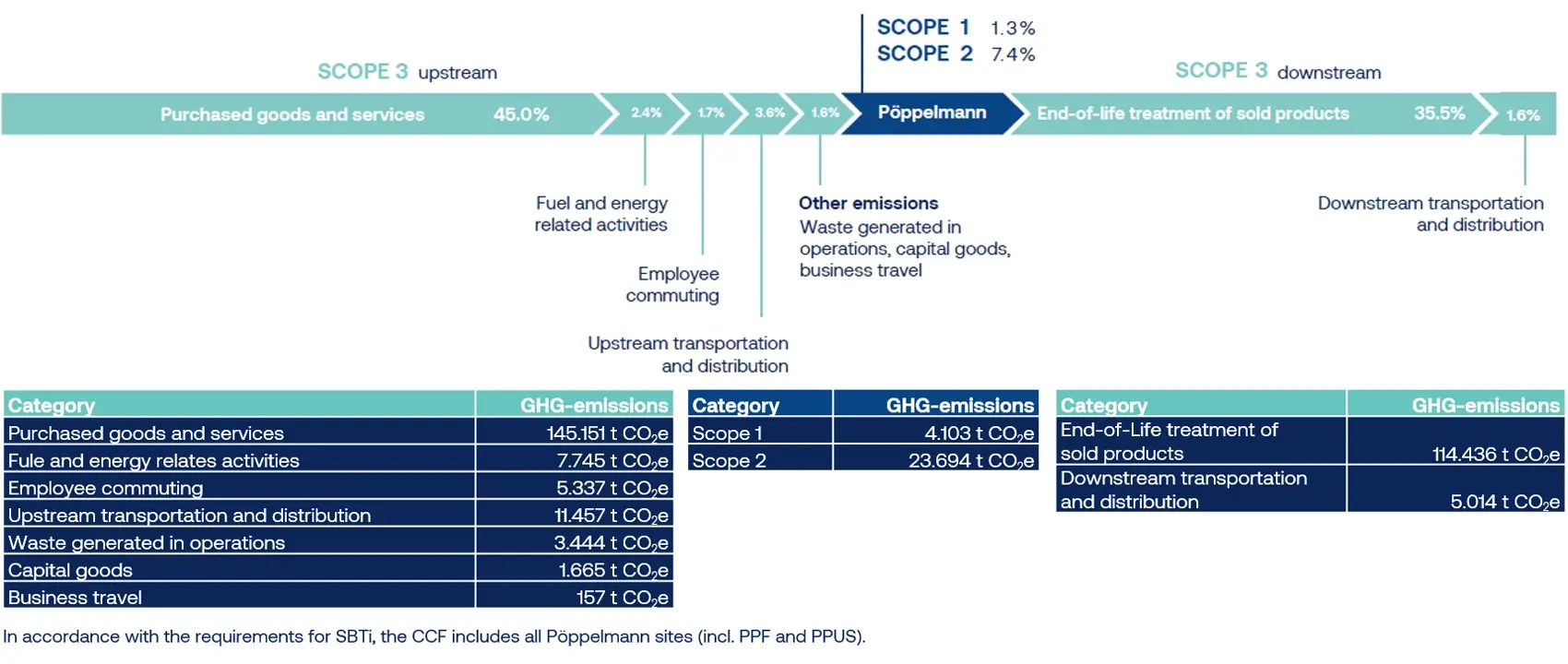Information on Pöppelmann's climate strategy
The goal of sustainable management and action has characterised Pöppelmann's corporate objectives for many years. We have been participating in the European Union's Eco-Management and Audit Scheme (EMAS) on a voluntary basis since 1996.
In 2021, we decided to expand our established environmental and energy management system to include a climate management system. In this context, we have expanded our key aspect of greenhouse gas emissions to include our Scope 3 emissions, set ourselves science-based climate targets and formulated a climate programme.
We used the methodology of the Science Based Targets initiative (SBTi) to develop the climate targets.
Validation by the Science Based Targets initiative followed in 2023. This confirmed that our climate targets are in line with the 1.5 degree target of the Paris Climate Agreement.
The greenhouse gas emissions of Pöppelmann (CCF) show us
the sources and the reduction potentials.


In order to address the increasingly important environmental aspect of greenhouse gas emissions, we are currently developing a climate strategy.
As part of this strategy development, we first determined the Corporate Carbon Footprint (CFF) for the year 2021.
Overall, Pöppelmann is directly and indirectly responsible for 322,203 t CO2e greenhouse gases through its business activities.
Of these, our Scope 1 emissions account for approx. 1.3% and our Scope 2 emissions for approx. 7.4%.
Indirect Scope 3 emissions account for a total of 91% of the CCF.
These are mainly determined by the categories "Purchased goods and services" with approx. 45% (herein mainly our purchased plastics) and "End-of-life of products" with approx. 36% (herein mainly the products that are incinerated).
In December 2022, we set our climate targets. We used the methodology of the Science Based Targets initiative (SBTi) to develop the climate targets.
Pöppelmann officially committed to SBTi at the end of 2022. The validation of the climate targets by SBTi are still pending.
We are already working on many measures to achieve the target. Among other things, the addition of photovoltaic systems on company-owned buildings (6,000 kWp by the end of 2024) will contribute to the reduction of our Scope 2 emissions. For the reduction of Scope 3 emissions, our biggest lever is the circular economy, as we reduce emissions from "Purchased goods and services" through the use of recyclates and emissions from the "End-of-life of products" through recycling-friendly design.

Reduce energy consumption
- Use of energy-saving production systems and peripheral devices
- Utilisation of waste heat (compressors, chillers) for heating buildings
- Use of LED lighting
Generate renewable energy yourself
- Addition of PV systems with 6,000 kWp by 2024 on our own hall roofs
- Examination of further options (car park PV, wind energy)
Procuring renewable energy
- Energy supply with the highest possible proportion of renewable energies
- Direct contracts with operators of energy generation plants (PPAs)
Electrify
- Electrification of processes that currently still require (fossil) fuels
- Electrification of vehicle fleet
Reduce
- Optimised, weight-reduced design
- Weight-reducing manufacturing processes (thermoforming, MuCell®)
Reuse
- Development of reusable products
- Use of reusable containers (internal and external)
- Reuse of packaging material
Recycle
- Use of recyclates (from used products or production waste)
- Production of recyclable products
- Development of return logistics for used products
Rethink
- Use of optimised process aids (e.g. energy-saving hydraulic oils)
- Reduction of transports through packaging optimisation
→ We reduce Scope 3 primarily through cooperation in the value chain.